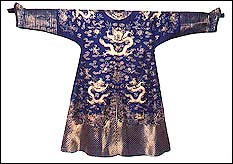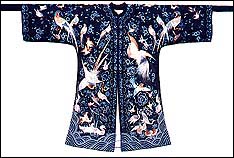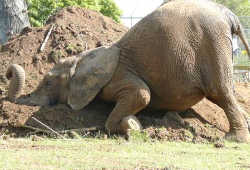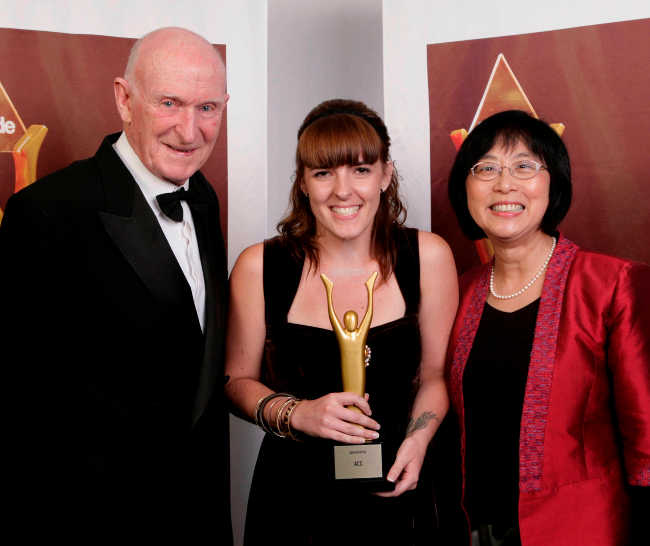Dorothy – 4/9/98
An exhibition of Chinese costumes and textiles at the Otago Museum – April to June 1998. If you haven’t already, read last week’s article on the The Otago Museum’s textile curator.
This exhibition began through an approach from the Dunedin Chinese community who wanted to make a special celebration of China Week in recognition of the 150th anniversary of Otago. They requested an exhibition of the Chinese costumes and textiles held in the museum. This collection has been built up over the last eighty years through donations but most of the items had not been exhibited previously.
Link with Chinese goldmining in Central Otago Adjoining this display was an archaeological exhibition featuring artefacts excavated in Central Otago where Chinese goldminers worked. The earlier gold rushes occurred in the 1860s, but the Chinese miners continued after the gold fever had subsided and most of the miners had gone to seek their fortunes in other areas. They were still active in Central Otago after the turn of the century. This led to an interesting link with the New Zealand Presbyterian Church which established a mission in villages near Canton where the gold miners’ homes and families were.
Gifts to Museum from missionaries working in China This mission work in turn led to some of the Dunedin missionaries who worked in China giving some of the Chinese costumes and textiles to the museum. These gifts ranged from small artefacts to large costumes. The missionaries were working in China on very small salaries, not wealthy people who could go to the big cities to purchase goods. Some of the material was brought out by the missionaries to sell locally through the church groups and raise funds for the missions.
These donors included Miss Mary Moore who went to China as a missionary in 1896, the Rev George McNeur, the first missionary at the Canton Village Mission of the New Zealand Presbyterian Church in South China, established in 1902, and Miss Annie Hancock, a teacher missionary from Dunedin. There were also gifts from the Rev. William Hewitson, convener of the Foreign Missions Committee of the New Zealand Presbyterian Church, who visited China in 1906 and again in 1915, and his collection of some important costumes was donated in 1948.
Help from the Victoria and Albert Museum in London In the 1960s this museum arranged donations to the Otago Museum from English collectors and missionaries.
Display of the garments The garments were hung on fabric-covered padded rods and suspended from the ceiling by nylon filament thread. They were hung so that both sides of the garments could be seen clearly – an arrangement greatly appreciated by those viewing the exhibition as both the front and the back of the garments feature rich and intricate embroidery. Silk and gold embroidery is the dominant decorative feature, but some garments and hangings are fine silk and gold tapestry weave with the design woven as the fabric was constructed.
Entrance through theatre hanging Visitors entered the exhibition through an archway hanging, originally used as a Chinese theatre backdrop.
Two outstanding garments Margery Blackman in the exhibition catalogue describes them as follows:
“Summer dragon robe for official
 |
| Summer dragon robe for official (Click here for a larger version) |
“Decorated with eight mang (four claw) dragons in standard format. Some of the usual emblems. The light open fabric indicates its use in summer. Blue open gauze weave in silk and ramie. Gold and silver wrapped embroidery threads. Black and white floss for eyes of dragon. Couching. Five spherical open work metal buttons. Late 19th century 140 cm x 196 cm Presented by Rev W Hewitson”
“Woman’s informal surcoat Centre front opening calf length coat decorated with Chinese birds and flowering plants. Against a background of flowering plants in shades of blue, Chinese birds fly, swim and perch. Mandarin ducks, geese, herons, pheasants, parrots, tree creepers, doves and warblers are all carefully observed and translated by the embroiderer. Navy silk satin with cream satin lining. Plants are worked with under padding using 2-ply silk spun threads, using satin and knot stitches. The birds are worked in floss silk using a variety of flat stitches. Early 20th century 108 cm x 144 cm”
 |
| Woman’s informal surcoat (Click here for a larger version) |
Conservation work As the fabrics deteriorate naturally with age the silk becomes weaker. A lot of the linings which are very fine silk are seriously damaged. For six months before the exhibition a large amount of specialised textile conservation was done to provide safe support before exhibiting them. Margery had skilled assistance in this task from Jan Wilson.
One hanging was moth eaten around the edge and had to be backed on to a matching red cotton.
Natural history feature In addition to the costumes and textiles there was a natural history feature about the birds embroidered on the garments and live silk worms in their box could be seen feeding on mulberry leaves and spinning cocoons of silk.
Educational value The education staff at the museum made great use of the exhibition for school visits, and Margery took guided tours for groups of the public and special groups from the tertiary institutions, such as the senior clothing students from the Home Science School.
Exhibition’s success a team effort
Margery is quick to give credit for much of the success of the exhibition to the wonderful support and cooperation and design work of the exhibition staff.
Exhibition catalogue The catalogue for this exhibition 76written by Margery Blackman (link to the article about her) gives a great insight into the collection. It contains interesting text and some magnificent colour photographs.
The catalogue includes the historical background to the exhibition, descriptions of the Ch’ing Dynasty dress, ceremonial costume, informal costume, footwear, and accessories. There is a discussion of the fabrics used, the designs and their significance, and techniques used in creating the garments and the embroidery. It also includes a bibliography for further study.
Purchasing the catalogue If you missed the exhibition but want to experience it through the written word, contact the Otago Museum Shop at:
| Otago Museum 419 Great King St P.O. Box 6202 Dunedin | Phone: (03) 477-2372 Fax: (03) 477-5993 Email: mail@otagomuseum.govt.nz |
You can purchase this beautiful book for NZ$13.95 plus NZ$2.00 for postage and packing.




